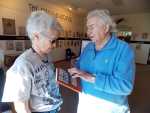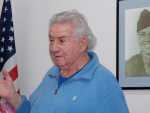Holocaust survivor visits Stars and Stripes Museum

Ben Fainer was just nine and a half years old in 1939 when he and his family were forcibly removed from their home in Bedzin, Poland by Nazi soldiers. Ben, who was big for his age, told the soldiers he was fifteen and a half and thus was put into the group with those capable of working. The elderly and women with small children, such as Ben's mother and three siblings, were placed into other groups and sent to extermination camps.
Ben, his father, and the other men of the town were trucked to a makeshift forced labor camp in Jelesnia, Poland. Fainer was put to work cleaning offices and shining shoes for the soldiers. Prisoners who worked too slowly were beaten; those who fell ill or injured were murdered. Prisoners were fed one or two bowls a day of a soup made of leftovers from the guards' kitchen. Sometimes sawdust was mixed in as filler. The prisoners were allowed about three hours of sleep each night.
After 8 months at Jelesnia, the prisoners were forced to march to Blechhammer concentration camp, a distance of nearly 100 miles. At Blechhammer Fainer was tattooed with a number that became his identity, 178873. He was assigned a similar job of cleaning and shoe-shining in the offices and if he had an opportunity, he would steal food or cigarettes to take back to his fellow prisoners, even though stealing was punishable by hanging.

After about fifteen months, the prisoners were again forced to march, this time to Buchenwald, Germany. This is where Fainer, who was not yet thirteen, was given his first job as a grown man, and where he first encountered the crematoria--the buildings designed to burn the bodies of the millions of people murdered by the Nazis. But, according to Fainer, not just bodies were burned in the crematoria. Fainer witnessed on a daily basis men who were still alive but unable to walk being placed in the crematoria. The crematoria burned all day every day; the remaining prisoners breathed the ashes of the dead.
A year later, Fainer was among a group forced to march to the camp at Gross Rosen, and then a few months later he was marched to Flossenburg. After staying at Flossenburg for a year, he marched again before being loaded onto a train of cattle cars. The train was later attacked by American planes and Fainer and the other prisoners briefly escaped before being rounded up by SS soldiers. They were then marched to Dachau, where Fainer stayed for only 10 days before beginning another march. It was during this march, on April 23, 1945 that the German soldiers guarding Fainer's group were attacked by American forces and Fainer was liberated.
Fainer later migrated to Dublin, Ireland, then Canada, and finally to the U.S. He became a U.S. citizen in 1962. He didn't speak about his experience for over 60 years; even his children had no idea he survived the Holocaust. About 16 years ago a friend convinced Fainer to tell his story and he began the undertaking of writing a book, "Silent for Sixty Years," and creating a video.
During this process, Fainer was finally able to celebrate his bar mitzvah, a ceremony celebrating the transition of a boy into a man. The event made the newspapers and caught the attention of one Fainer's liberators, Norris Nims, a sergeant in Company K, 26th Yankee Division of the U.S. Army. Nims contacted Fainer and the two were able to reconnect before Nims' passing in 2011.
Fainer, now 83, resides in St. Louis and has dedicated his life to telling his story and dispelling myths spread by Holocaust deniers. 11 million people were murdered during the Holocaust, 6 million of whom were Jewish. Fainer claims to be the youngest living survivor.
